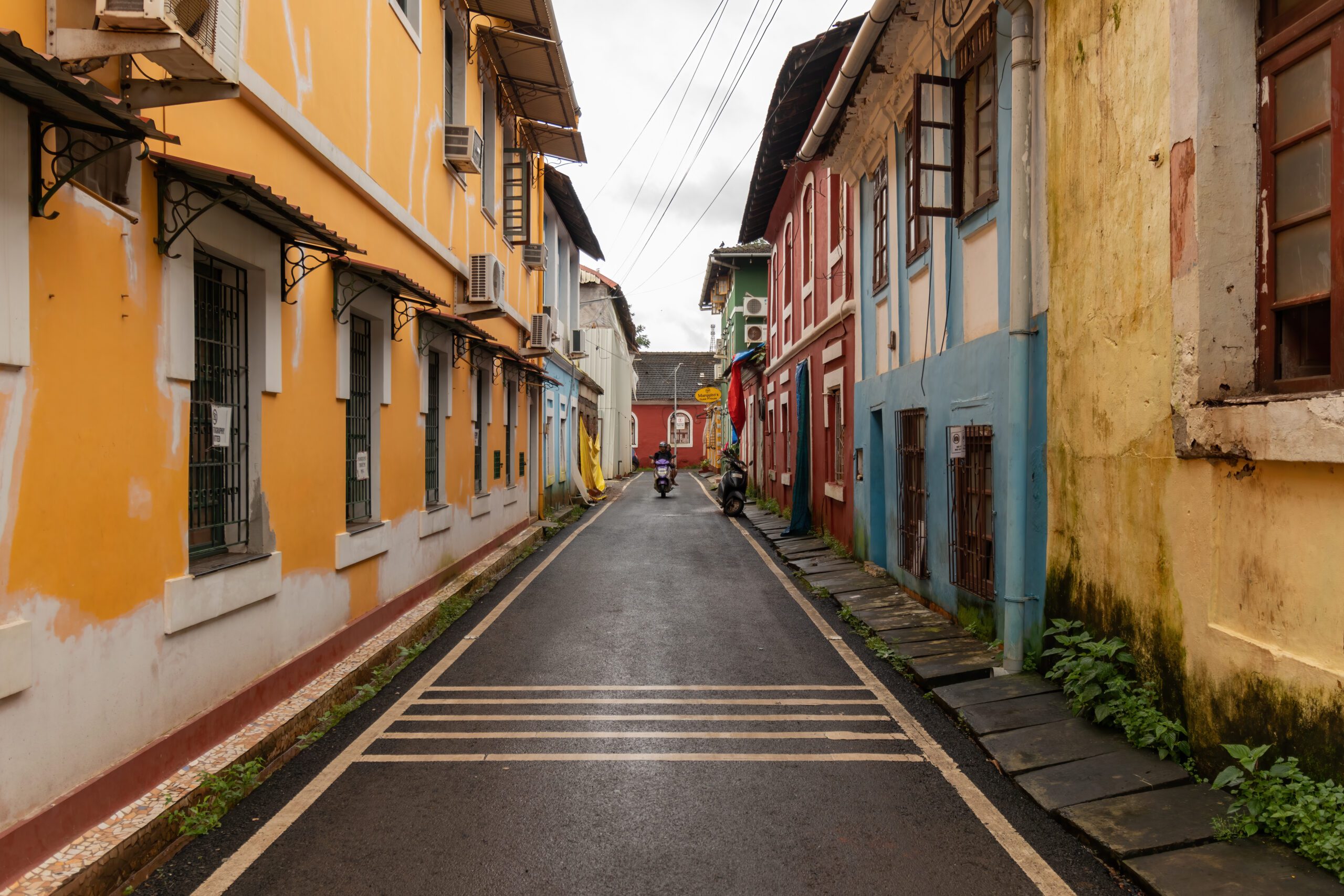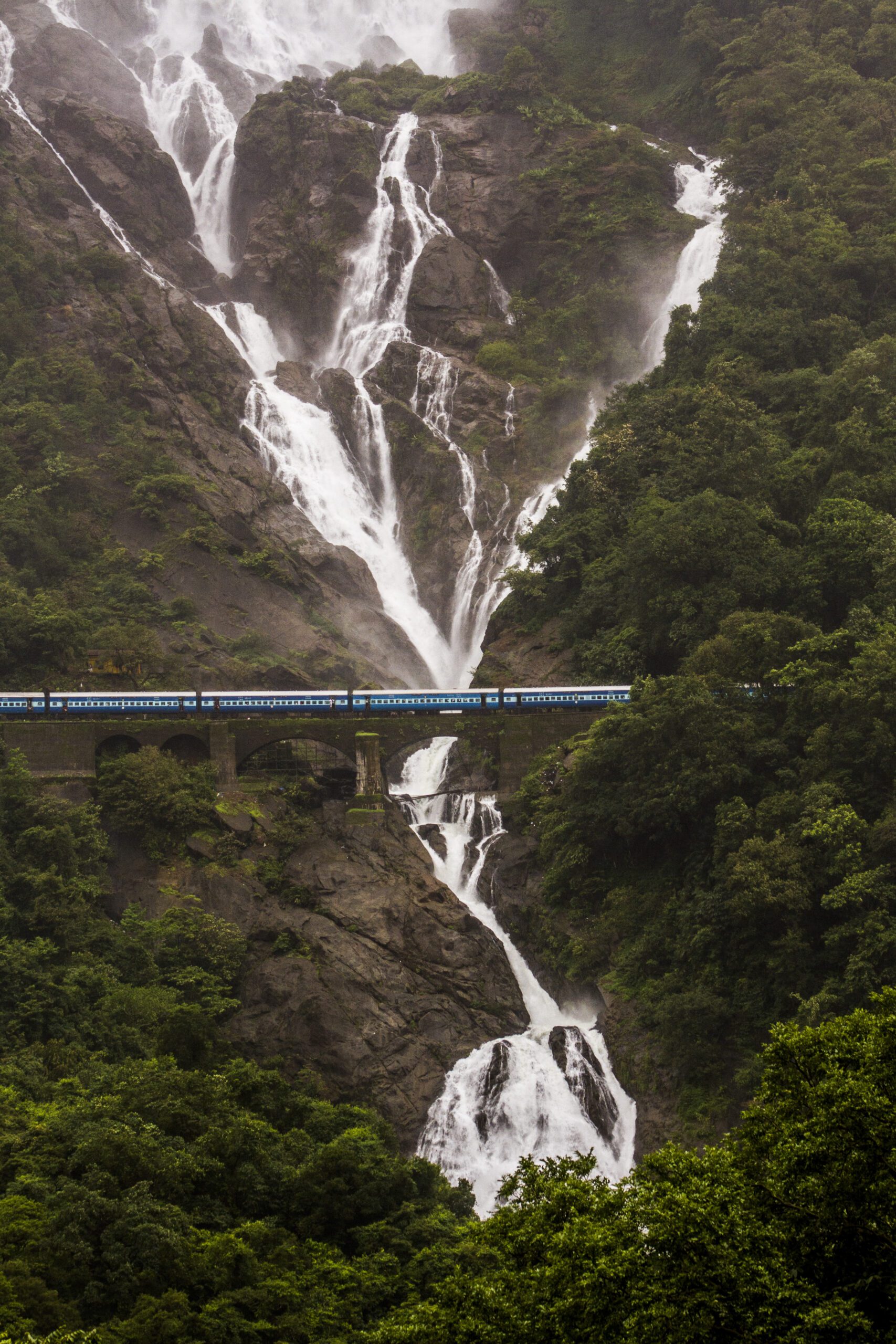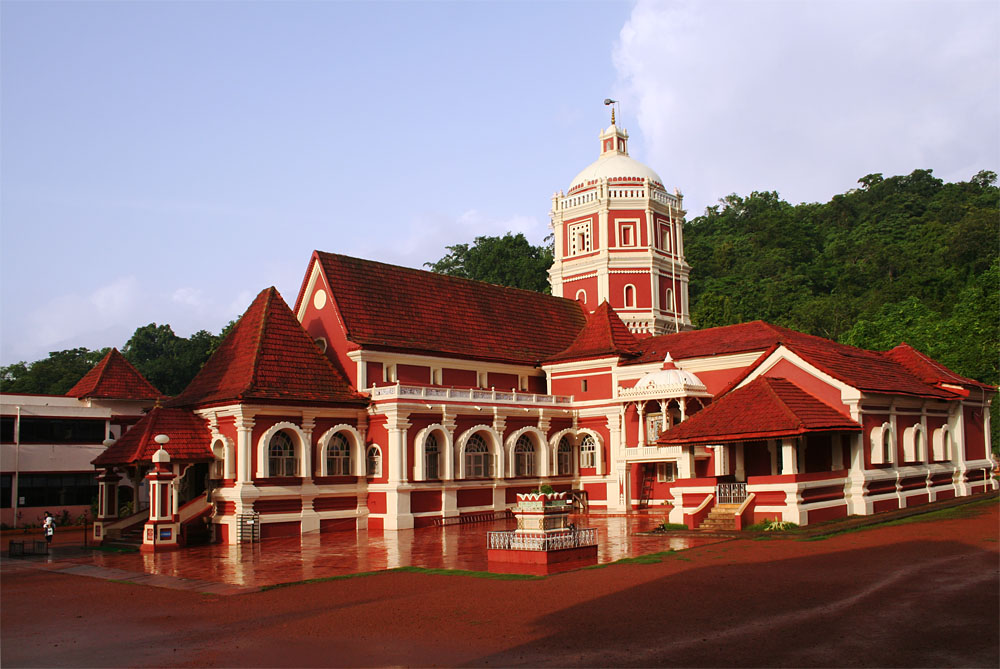
Fontainhas is the charming Latin Quarter nestled in the heart of Panjim, Goa’s capital city. Renowned for its vibrant, narrow streets lined with colorful Portuguese-style houses, Fontainhas is a living museum of Goa’s colonial heritage. With its tiled roofs, ornate balconies, and pastel facades, the area evokes a distinctly European feel, transporting visitors to a bygone era.
The name “Fontainhas” comes from the natural springs at the base of nearby Altinho Hill. Established in the late 18th century by a Goan of Portuguese descent, this quarter was once home to administrative elites and remains one of Asia’s only Latin Quarters still in use today. Walking through Fontainhas feels like stepping into an old-world postcard, where traditional bakeries, heritage homes, art galleries, and quaint cafés blend seamlessly with Goan culture and Portuguese legacy.
History of Fontainhas
Fontainhas, located in Panjim (Panaji), is one of the most iconic heritage quarters in India, known for its strong Portuguese influence and colonial charm. Its history is deeply rooted in Goa’s colonial past under Portuguese rule, which lasted for over 450 years.
1. Origins & Development
Founded in the late 18th century, Fontainhas was established by António João de Sequeira, a wealthy Goan expatriate who returned from Mozambique. He named it Fontainhas after the natural spring (Fonte Phoenix) that flowed at the base of the Altinho Hill, providing fresh water to the area.
The area was developed in the style of a Portuguese bairro (neighborhood), inspired by Lisbon’s old quarters. Its winding lanes, pastel-hued homes, red-tiled roofs, and iron balconies mirror the typical Portuguese architectural sensibility.
By the 19th century, Fontainhas had become a prominent residential area for Portuguese bureaucrats, clergy, and the elite, forming the cultural and administrative hub of Panjim. This led to the construction of important buildings like the Chapel of St. Sebastian (1818) and several colonial homes.
2. Colonial Significance
During Portuguese rule, Panjim replaced Old Goa as the capital in 1843, and Fontainhas became the epicenter of urban European life in Goa.
The residents of Fontainhas spoke Portuguese, practiced Catholicism, and followed European customs, making the neighborhood an enclave of European culture in India.
The Chapel of St. Sebastian remains a key historical structure from this period. It houses a unique crucifix with open eyes—brought from Old Goa—meant to instill fear during the Inquisition.
3. Post-Liberation Preservation
After Goa’s liberation from Portuguese rule in 1961, Fontainhas retained its architectural and cultural heritage, even as the rest of Panjim modernized.
Despite urban development, many of the original Portuguese-style homes are still owned by descendants of the original families, who maintain them under heritage norms.
It has been officially recognized as a Heritage Zone by the Government of Goa and is now protected to preserve its historical and cultural essence.
4. Modern-Day Significance
Today, Fontainhas is known for its art galleries, heritage walks, and Portuguese-Goan fusion cafés and bakeries. Events like the Fontainhas Art Festival celebrate its legacy through visual arts, music, and food.
It remains a living testament to Goa’s unique East-meets-West history—a neighborhood where time stands still, offering a glimpse into colonial-era life preserved through architecture, language, and tradition.
Significance of Fontainhas
Fontainhas is not just a neighborhood—it’s a cultural and historical gem that reflects the soul of Goa beyond its beaches. Here’s why Fontainhas holds such significance:
1. Cultural & Architectural Heritage
- Fontainhas is Asia’s only surviving Latin Quarter, showcasing authentic Portuguese architecture with narrow cobbled streets, pastel-hued houses, tiled roofs, and wrought-iron balconies.
- The area has been declared a heritage zone by the Government of Goa to preserve its colonial character.
2. Window into Goa’s Colonial Past
- It offers a living snapshot of Portuguese-era Goa, where architecture, street names, and even some spoken Portuguese remain.
- The neighborhood reflects the blend of Indo-Portuguese traditions, especially in art, religion, food, and daily life.
3. Artistic & Literary Influence
- Fontainhas hosts the annual Fontainhas Art Festival, bringing together artists, musicians, and writers from all over India and the world.
- Galleries like Gitanjali Art Gallery and colorful murals make it a vibrant hub for the creative community.
4. Religious Importance
Home to historic structures like the Chapel of St. Sebastian, which contains relics from the Old Goa Inquisition era, adding spiritual and historical depth to the area.
5. Tourism & Photography Hotspot
- One of the most photogenic and Instagram-worthy places in Goa, often featured in travel magazines and heritage tourism circuits.
- A favorite for walking tours, storytelling sessions, and architectural photography.
6. Goan-Portuguese Culinary Blend
From traditional Goan sweets at Confeitaria 31 de Janeiro to local taverns like Joseph Bar, Fontainhas celebrates the fusion of Goan and Portuguese cuisines.
7. Symbol of Peaceful Coexistence
The area stands as a symbol of cultural harmony, where Hindu temples, Catholic chapels, and colonial homes coexist peacefully—a hallmark of Goa’s pluralistic identity.
What to explore at Fontainhas
1. Portuguese-Style Architecture
- Stroll through narrow lanes lined with colorful heritage houses featuring red-tiled roofs, oyster-shell windows, and wrought-iron balconies.
- Look for unique street signs in Portuguese and little shrines embedded into house facades.
2. Chapel of St. Sebastian
- Built in 1818, this serene white chapel is known for a rare crucifix with Christ’s eyes open—once used during the Inquisition.
- It’s a peaceful spiritual spot that anchors the area historically and visually.
3. Confeitaria 31 de Janeiro
- A legendary 80+ year-old Goan-Portuguese bakery famous for traditional sweets like bebinca, dodol, and freshly baked pão (bread).
- A must-stop for food lovers.
4. Art Galleries & Cultural Spaces
- Gitanjali Art Gallery – Exhibits works by Indian and Scandinavian artists, and hosts workshops and readings.
- Velha Goa Galeria – Focuses on Goan and Portuguese art, azulejos (ceramic tiles), and local crafts.
- Fundação Oriente (Panjim Inn) – Supports Indo-Portuguese cultural ties and regularly displays exhibitions.
- Street Murals & Wall Art- Look out for vibrant murals painted by local and international artists, often depicting Goan life, musicians, roosters, and folklore.
5. Traditional Goan Cafés & Taverns
- Viva Panjim – Set inside a heritage home, it serves authentic Goan-Portuguese cuisine.
- Joseph Bar – A cozy, retro tavern known for local brews, live music, and a classic Fontainhas vibe.
- Hospedaria Venite – Famous for its old-world charm and seafood dishes.
6. Altinho Hill & Maruti Temple
- A short walk uphill offers panoramic views of Fontainhas and Panjim.
- Visit the Maruti Temple, dedicated to Lord Hanuman, glowing beautifully in the evening.
7. Bookstores & Boutiques
- Explore small independent bookstores with literature on Goan culture and history.
- Boutique shops often sell local handicrafts, azulejo tiles, and Portuguese-inspired souvenirs.
8. Heritage Walks
- Join a guided walking tour to uncover stories behind the buildings, families, and festivals of the area.
- These often include a visit to hidden alleys, fountains, and insider food spots.
9. Photography & Instagram Spots
- Every corner here is photogenic—especially the Rue de Natal, Rua 31 de Janeiro, and Panjim Inn’s façades.
- Early mornings or late afternoons give the best lighting for pastel-tone photos.
How to reach Fontainhas
From Goa International Airport (Dabolim) – ~27 km
1. By Taxi / Cab:
- Easiest and most convenient option.
- Takes ~45–60 minutes depending on traffic.
- Cost: ₹800–₹1,200 (prepaid taxi available at the airport).
2. By Bus:
- Take a bus from the airport to Panjim Bus Stand (Kadamba Bus Terminal) via Vasco or Margao.
- Then, walk or take an auto to Fontainhas (~1.5 km).
From Panjim City / Kadamba Bus Stand – ~1.5 km
3. By Auto-Rickshaw:
- Takes ~5–10 minutes.
- Cost: ₹30–₹50 (negotiable).
4. By Walking:
- A scenic 15–20 minute walk through Panjim’s quiet streets.
- Start near the Immaculate Conception Church and walk toward Rua 31 de Janeiro.
5. By Rental Scooter or Car
- Available all over Goa, including in Calangute, Baga, and Panjim.
- Scooter rental: ₹300–₹500/day
- Car rental: ₹1,200–₹2,000/day
Best Time to Visit Fontainhas
Fontainhas is a year-round destination, but certain times offer a better experience depending on weather, lighting, and events:
Best Season: November to February (Winter)
- Cool, dry, and pleasant weather (20–28°C)
- Ideal for: Walking tours, photography, art festivals, and relaxed café hopping
- Bonus: Fontainhas looks especially fresh and colorful after the monsoons
Best Time of Day: Morning or Late Afternoon
Morning (8–10 AM):
- Soft natural light is perfect for photography
- Streets are quieter—less crowd and traffic
- Great time to start a walking tour or visit a local bakery
Late Afternoon to Sunset (4–6 PM):
- Gentle lighting enhances the pastel buildings
- Good time to end your walk with snacks or a drink at Joseph Bar or Café Bodega
Special Time: During Fontainhas Art Festival (Usually February)
Annual event with:
- Art exhibitions in old houses
- Live music and cultural performances
- Street art, open studios, and local craft sales
- It’s the best time to experience the cultural soul of Fontainhas
Things to Carry & Tips to Prepare for Your Visit to Fontainhas
1.Dress Smart:
Opt for light, breathable clothing and comfortable walking shoes, as you’ll be exploring on foot. Don’t forget sunglasses and sunscreen—Goa’s sun can be quite strong even in winter.
2. Essentials to Bring:
Carry a refillable water bottle to stay hydrated, a smartphone or camera for capturing the vibrant surroundings, and a small amount of cash for buying snacks or souvenirs at local cafés and shops (many places may not accept cards).
3.Be a Responsible Visitor:
Fontainhas is a peaceful, lived-in neighborhood, not just a tourist attraction. Keep noise to a minimum, respect private homes and property, and avoid blocking narrow streets or stairways. Drone use is restricted—always seek permission before flying one.
Self-Guided Walking Tour of Fontainhas
1. Begin your journey at Confeitaria 31 de Janeiro, one of Goa’s oldest Portuguese bakeries. Start your day with a traditional snack like bebinca or a hot pão (Goan bread) fresh out of the oven.
2. From here, stroll down the iconic Rua 31 de Janeiro, the heart of Fontainhas. This street is lined with pastel-colored houses, ornate balconies, and azulejo name tiles—perfect for photography lovers and architecture buffs.
3. As you walk, weave your way through the cozy, winding side lanes. Keep an eye out for charming stairways, colorful wall murals, tucked-away chapels, and artistic tile work. This is where Fontainhas reveals its true soul—quiet, artistic, and full of hidden gems.
4. Make your way to the historic Chapel of St. Sebastian, known for its peaceful white façade and a rare crucifix with Christ’s eyes open—a relic from the Inquisition era.
5. Just a short walk away is Fonte Phoenix, the natural spring that gave Fontainhas its name. Tucked below Altinho Hill, this centuries-old fountain once served as a lifeline for the local community.
6. Continue toward the elegant Panjim Inn and nearby Gitanjali Art Gallery. Pause to enjoy some local art or grab a coffee at the adjacent café. This area offers a great blend of culture, history, and relaxation.
7. Wrap up your tour with an optional uphill walk to Altinho Hill. From here, you can visit the vibrant Maruti Temple and take in sweeping views of Fontainhas and the Mandovi River. Alternatively, stroll toward the grand Our Lady of the Immaculate Conception Church in Panjim’s main square for a fitting finale.


